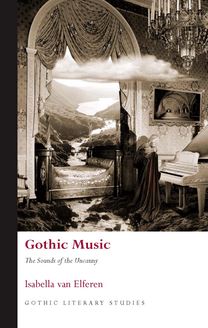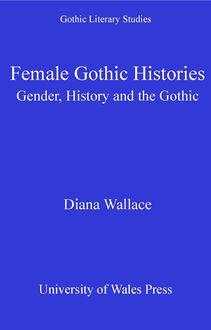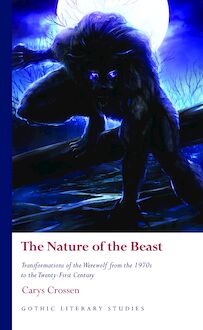-
 Univers
Univers
-
 Ebooks
Ebooks
-
 Livres audio
Livres audio
-
 Presse
Presse
-
 Podcasts
Podcasts
-
 BD
BD
-
 Documents
Documents
-
- Cours
- Révisions
- Ressources pédagogiques
- Sciences de l’éducation
- Manuels scolaires
- Langues
- Travaux de classe
- Annales de BEP
- Etudes supérieures
- Maternelle et primaire
- Fiches de lecture
- Orientation scolaire
- Méthodologie
- Corrigés de devoir
- Annales d’examens et concours
- Annales du bac
- Annales du brevet
- Rapports de stage
La lecture à portée de main
Découvre YouScribe en t'inscrivant gratuitement
Je m'inscrisHistory of the Gothic: Gothic Literature 1764-1824 , livre ebook
Découvre YouScribe en t'inscrivant gratuitement
Je m'inscrisEn savoir plus
En savoir plus

Description
Sujets
Informations
| Publié par | University of Wales Press |
| Date de parution | 01 décembre 2009 |
| Nombre de lectures | 0 |
| EAN13 | 9780708322611 |
| Langue | English |
| Poids de l'ouvrage | 3 Mo |
Informations légales : prix de location à la page 0,0500€. Cette information est donnée uniquement à titre indicatif conformément à la législation en vigueur.
Extrait
HISTORY OF THE GOTHIC
Gothic Literature
1764-1824
Carol Davison
University of Wales Press00 Prelims:Gothic Literature 1764-1824 22/10/09 13:34 Page i
GOTHIC LITERATURE 1764–182400 Prelims:Gothic Literature 1764-1824 22/10/09 13:34 Page ii
SERIES PREFACE
Gothic Literary Studies is dedicated to publishing groundbreaking
scholarship on Gothic in literature and film.The Gothic,which has
been subjected to a variety of critical and theoretical approaches,is
a form which plays an important role in our understanding of
literary, intellectual and cultural histories. The series seeks to
promote challenging and innovative approaches to Gothic which
question any aspect of the Gothic tradition or perceived critical
orthodoxy.
Volumes in the series explore how issues such as gender,religion,
nation and sexuality have shaped our view of the Gothic tradition.
Both academically rigorous and informed by the latest
developments in critical theory, the series provides an important focus for
scholastic developments in Gothic studies, literary studies, cultural
studies and critical theory.The series will be of interest to students
of all levels and to scholars and teachers of the Gothic and literary
and cultural histories.
SERIES EDITORS
Andrew Smith, University of Glamorgan
Benjamin F. Fisher, University of Mississippi
EDITORIAL BOARD
Kent Ljungquist,Worcester Polytechnic Institute Massachusetts
Richard Fusco, St Joseph’s University, Philadelphia
David Punter, University of Bristol
Chris Baldick, University of London
Angela Wright, University of Sheffield
Jerrold E. Hogle, University of Arizona00 Prelims:Gothic Literature 1764-1824 22/10/09 13:34 Page iii
HISTORY OF THE GOTHIC
Gothic Literature
1764–1824
Carol Margaret Davison
UNIVERSITY OF WALES PRESS
CARDIFF
200900 Prelims:Gothic Literature 1764-1824 22/10/09 13:34 Page iv
© Carol Margaret Davison, 2009
All rights reserved. No part of this book may be reproduced in any
material form (including photocopying or storing it in any medium by
electronic means and whether or not transiently or incidentally to some
other use of this publication) without the written permission of the
copyright owner except in accordance with the provisions of the
Copyright, Designs and Patents Act 1988.Applications for the copyright
owner’s written permission to reproduce any part of this publication
should be addressed to the University of Wales Press, 10 ColumbusWalk,
Brigantine Place, Cardiff, CF10 4UP.
www.uwp.co.uk
British Library Cataloguing-in-Publication Data
A catalogue record for this book is available from the British Library.
ISBN 978-0-7083-2009-9 (hardback)
978-0-7083-2045-7 (paperback)
e-ISBN 978-0-7083-2261-1
The right of Carol Margaret Davison to be identified as author of this
work has been asserted in accordance with sections 77 and 79 of the
Copyright, Designs and Patents Act 1988.
Printed by Gutenberg Press,Tarxien, Malta00 Prelims:Gothic Literature 1764-1824 22/10/09 13:34 Page v
CONTENTS
Series Editors’ Foreword vi
Acknowledgements vii
Chronology ix
Introduction and Critical Overview 1
1 Gothic Enlightenment/Enlightenment Gothic 22
2 Anatomizing the Gothic 55
3 The Female Gothic 83
4 Revolutionary Gothic/Gothic Revolutions 111
5 Female Gothic Reconfigurations 144
6 The Gothic Romantics/Romanticizing the Gothic 165
7 Revitalizing the Gothic 186
8 Afterword –Victorian Gothic 219
Endnotes 226
Bibliography 296
Annotated Bibliography 325
Index 35500 Prelims:Gothic Literature 1764-1824 22/10/09 13:34 Page vi
SERIES EDITORS’ FOREWORD
The History of the Gothic series consists of four volumes: Gothic
Literature 1764–1824, Gothic Literature 1825–1914, Twentieth
Century Gothic and American Gothic.The series provides a
comprehensive introduction to the history of Gothic Literature and to a
variety of critical and theoretical approaches. Volumes in the
series also raise questions about how the Gothic canon has been
received and seek to critically challenge, rather than simply
reaffirm, commonplace perceptions of the Gothic tradition.Whilst
intended as an introduction to the history of the Gothic they thus
also provide a rigorous analysis of how that history has been
developed and suggest ways in which it can be critically
renegotiated.
The series will be of interest to students of all levels who are
new to the Gothic and to scholars and teachers of the history of
Gothic Literature.The series will also be of interest to students
and scholars working more broadly within the areas of literary
studies, cultural studies, and critical theory.
Andrew Smith, University of Glamorgan
Benjamin F. Fisher, University of Mississippi00 Prelims:Gothic Literature 1764-1824 22/10/09 13:34 Page vii
Acknowledgements
I would like to thank Andrew Smith and Benjamin Fisher, the
series editors, who issued me the challenging invitation to write
this book.Their patience and encouragement has meant a great
deal to me, as has that of Dafydd Jones and the University of
Wales Press, during what has been a rather erratic production
process. I am also thankful to the anonymous reader of my
outline and the draft manuscript for invaluable commentary and
corrections. I am grateful to Palgrave/Macmillan for allowing me
to reprint revised sections from my book, Anti-Semitism and
British Gothic Literature (2004) and to Sir Simon Marsden for
allowing me, for a nominal fee, the use of his atmospheric image
of Duntroon Castle in Argyll, Scotland, for this book’s cover. I
also owe a debt of gratitude to the Canada-US Fulbright
program for supporting my stint as a Fulbright scholar at the
University of Virginia from September to December 2005.While
that award was for research for my next book on the Scottish
Gothic, it did double duty. I am grateful to former President Ross
Paul, Provost Neil Gold, Dean Cecil Houston and Karl Jirgens,
Head of English, at the University of Windsor, for pulling strings
to allow me to accept that award. Special thanks are due to
Heather Moore Riser, Head of Public Services, and the gracious
staff at the Albert and Shirley Small Special Collections Library at
the University of Virginia, which houses the world-renowned
Sadleir-Black Gothic collection.That such a collection should be00 Prelims:Gothic Literature 1764-1824 22/10/09 13:34 Page viii
Gothic Literature, 1764–1824
located in the subterranean space of an Enlightenment institution
founded by Thomas Jefferson, attended by Edgar Allan Poe and
visited by William Faulkner struck me as extremely appropriate
given my subject matter. My attendance there would have been
impossible without the assistance of my ever-gracious and
beloved parents. I dedicate this book, in part, to the memory of
Frederick S. Frank, who urged me to work with the Sadleir-Black
collection. His lifelong dedication to the field of Gothic
scholarship is a shining example to us all and he will be greatly missed. (I
am doing everything in my power to ensure thesicklytaper.com
lives on.) My old friends, Robert Murphy and Sylvie Roy in
Richmond, were tremendously accommodating hosts while I was
there, as is their way. Closer to home, I owe so much to the
hundreds of students at Concordia University, McGill University,
the University of Toronto and the University of Windsor, to
whom I have taught a broad spectrum of Gothic courses over the
past seventeen years.Without their questions, interest and
feedback, this book could never have been written. I also benefited
greatly from my course releases as the University of Windsor
Humanities Fellow in 2006 granted by the Humanities Research
Group, and am grateful for the assistance I continue to receive
from the ever-friendly and efficient staff at the Leddy Library,
University of Windsor. The wonderful Emily Wunder pulled
rabbits out of hats to efficiently alter the notation format at the
eleventh hour. During this and the indexing process Betsy
Keating was, as ever, a wonderfully precise and astute editorial
assistant and, more importantly, a true and dear friend. Darrin
Mara McAgy was at the opposite end of that spectrum,
reminding me on numerous horrible and traumatic occasions that
the Gothic is firmly rooted in real life. Giving birth to a book and
a baby, as a single mother with no family nearby, has been an
extremely challenging experience that I would not recommend
to even the most intrepid of scholars. My hideous progeny is
definitely the book and although she can’t yet read it, the book is for
the baby.
viii00 Prelims:Gothic Literature 1764-1824 22/10/09 13:34 Page ix
Chronology of major works
and relevant historic events
1700 John Pomfret’s A Prospect of Death.
1707 Act of Union between England and Scotland.
1715 First Jacobite Rebellion (‘The Fifteen’).
1717 Birth of Horace Walpole.
1722 Thomas Parnell’s ‘A Night Piece on Death’.
1729 Birth of Clara Reeve.
1742 Edward Young’s The Complaint, or Night Thoughts on Life,
Death, and Immortality (1742–5).
1743 Robert Blair’s The Grave.
1745 Second Jacobite Rebellion (‘The Forty-Five’); Giovanni
Battista Piranesi’s Carceri d’Invenzione (1745–61).
1746 James Hervey’s Meditations Among theTombs (1746–7).
1747 Thomas Warton’s On the Pleasures of Melancholy.
1750 Birth of Sophia Lee; Horace Walpole commences the
redesign of Strawberry Hill as part of a revival in Gothic
architecture.
1751 Thomas Gray’s ‘ElegyWritten in a Country Churchyard’.
1753 John Bond’s An Essay on the Incubus, or Night-mare.
1756 Birth of William Godwin; commencement of the Seven
Years War, which involved all of the major European
powers. Britain emerged as the world’s dominant colonial
power,while France lost its colonial power in theAmericas.00 Prelims:Gothic Literature 1764-1824 22/10/09 13:34 Page x
Gothic Literature, 1764–1824
1757 Edmund Burke’s A Philosophical Enquiry into our Ideas of
the Sublime and the Beautiful.
1760 Death of George II; birth of William Beckford.
1761 Death of Samuel Richardson.
1762 Richard Hurd’s Letters on Chivalry and Romance; James
Macpherson’s Finga
-
 Univers
Univers
-
 Ebooks
Ebooks
-
 Livres audio
Livres audio
-
 Presse
Presse
-
 Podcasts
Podcasts
-
 BD
BD
-
 Documents
Documents
-
Jeunesse
-
Littérature
-
Ressources professionnelles
-
Santé et bien-être
-
Savoirs
-
Education
-
Loisirs et hobbies
-
Art, musique et cinéma
-
Actualité et débat de société
-
Jeunesse
-
Littérature
-
Ressources professionnelles
-
Santé et bien-être
-
Savoirs
-
Education
-
Loisirs et hobbies
-
Art, musique et cinéma
-
Actualité et débat de société
-
Actualités
-
Lifestyle
-
Presse jeunesse
-
Presse professionnelle
-
Pratique
-
Presse sportive
-
Presse internationale
-
Culture & Médias
-
Action et Aventures
-
Science-fiction et Fantasy
-
Société
-
Jeunesse
-
Littérature
-
Ressources professionnelles
-
Santé et bien-être
-
Savoirs
-
Education
-
Loisirs et hobbies
-
Art, musique et cinéma
-
Actualité et débat de société
- Cours
- Révisions
- Ressources pédagogiques
- Sciences de l’éducation
- Manuels scolaires
- Langues
- Travaux de classe
- Annales de BEP
- Etudes supérieures
- Maternelle et primaire
- Fiches de lecture
- Orientation scolaire
- Méthodologie
- Corrigés de devoir
- Annales d’examens et concours
- Annales du bac
- Annales du brevet
- Rapports de stage




















